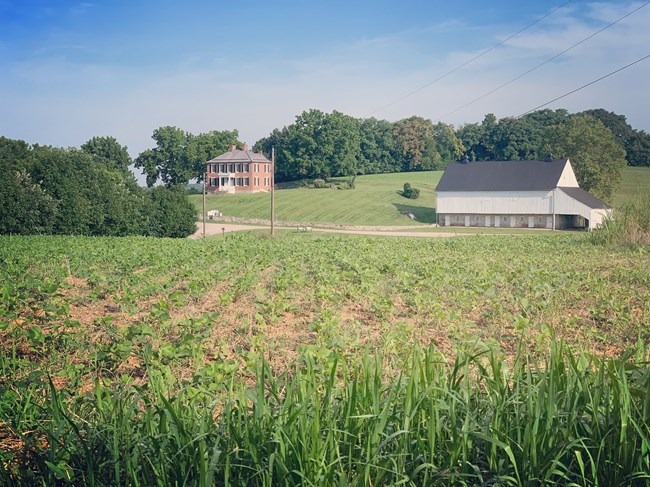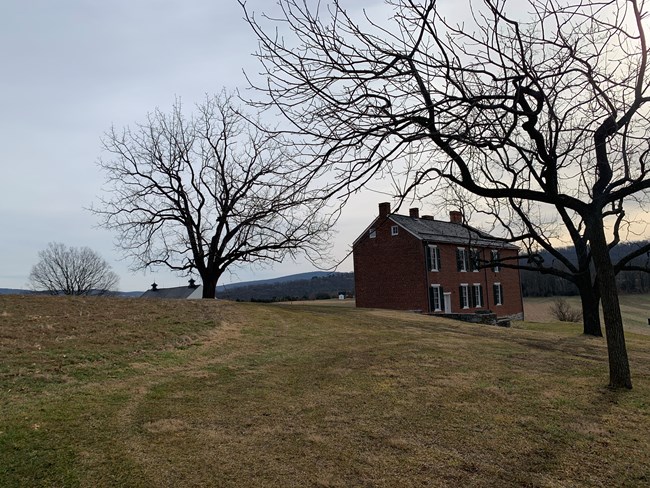
NPS Antietam/ B.Baracz The Philip Pry Farm and FamilyFor Philip and Elizabeth Pry and their five children, their lives were changed forever by a knock on the door. Their stately home stands on high ground overlooking Antietam Creek and the rolling hills of Western Maryland beyond. On most September days, the view from the Pry’s home was as peaceful as it was beautiful. However, September of 1862 was unlike any other before or since. That September would bring fear, suffering and death to the Pry home.Brothers Philip and Samuel Pry built the house 1844. After Philip married Elizabeth Cost in 1847, the couple occupied the home while Samuel and his family moved to a nearby mill. Fifteen years later in 1862 Philip and Elizabeth Pry had five living children; Samuel Jr., the oldest has just turned 14 and the youngest, Annie, had just turned two. 
Antietam NPS / B.Baracz The BattleTwo days before the battle of Antietam, a soldier pounded on the door, and when they answered, a Union soldier told the Prys that the Union Army of the Potomac was taking over their farm. Fifteen thousand soldiers of the Union Second Corps settled onto their property all day on September 15. The next day, a throng of officers moved into the house itself including the army’s commander General George Brinton McClellan. McClellan’s primary headquarters was located just to the east outside of the town of Keedysville, but from there General McClellan could not see Lee’s Army of Northern Virginia that has massed on the hills just west of Antietam Creek. Edmund Randolph Brown of the 27th Indiana remembered that, “from that higher ground a view could be had of some of the positions of the enemy. Soldiers of the Twenty-seventh relate that General McClellan and other officers came, during the afternoon of the 16th, and were taking observations from this high ground. So many soldiers gathered around them that they drew the fire of a rebel battery. The general did not retire himself, but he gave personal directions for the soldiers to do so.” McClellan spent the night before the battle in the Pry House. Philip Pry also stayed at the house. Mrs. Pry and her children escaped to a safer location at the Keedysville farm of Jacob Keedy. McClellan remained at the Pry House on the seventeenth and except for when he advanced across Antietam creek, McClellan and his staff would watch the battle though field glasses from the family home and yard. A reporter with the Boston Journal wrote: Turning from the conflict on the right, I rode down the line, toward the center, forded the Antietam and ascended the hill east of it to the large square mansion of Mr. Pry, where General McClellan had established his headquarters. The general was sitting in an arm-chair in front of the house. His staff were about him; their horses saddled and bridled, were hitched to the trees and fences. Stakes had been driven in the earth in front of the house, to which were strapped the headquarters telescopes, through which a view of the operations and movements of the two armies could be obtained. It was a commanding situation. The panorama included fully two-thirds of the battlefield, from the woods by the Dunker Church southward to the hills below Sharpsburg. Allegedly, McClellan went to the attic of the house where there was a trap door and stood on a barrel to look out over the battle. There is still a trap door in the roof of the house today. On the high ground adjacent to the house, McClellan’s Chief of Artillery placed some of his long-range rifled cannon. All day on the seventeenth the heavy guns pounded southern soldiers a mile to the west. The Pry House was also advantageously situated to be able to receive signal flag messages from both the left and right wings of McClellan’s army. Historian Willard Brown wrote: At 10 a.m. (September 16), there had been established on the field at Antietam a station communicating with the lookout on Washington; one with the left of General Burnside's forces, that connected with Elk Mountain; and one on the right with General Meade. A station of observation had been constructed on the crest of Elk Mountain (Red Hill) at the gap cut for the convenience of the officers and designated by the soldiers ''McClellan's Gap." The extensive view from this position commanding Sharpsburg and Shepherdstown, and also main points of the battlefield, with its approaches …. All the stations established were placed in communication with the central station at headquarters (Pry house) …. Lieutenant Stone remained at headquarters where he received the messages constantly coming in from all parts of the fields. As the battle raged across the creek, soldiers and officers at all levels of command were shot down. General Joseph Hooker, who led the Army’s First Corps, was struck by a bullet early that morning. He was brought to the Pry House so that surgeons could tend to his wounded foot that had filled his boot with blood. A shell fragment struck Major General Israel Richardson as he led the Union attack at Bloody Lane. Eventually moved to the Pry House, Richardson was treated there for his injury and for pneumonia. When she heard about her husband’s condition, Richardson’s wife Frances, along with her sister-in-law, travelled to Sharpsburg to care for him. Frances wrote, “Israel is slowly but steadily improving [but he] has grown very thin and very weak. He is very much depressed, not at all like himself, and inclined to look on the dark side, more than is good for him.” The AftermathBy September 20, 1862, McClellan had moved his headquarters south of Sharpsburg. Although McClellan and his staff only occupied the Pry House for a few days, the army presence continued as the Pry Barn was used as a field hospital for Union soldiers until they could be moved to Frederick, MD. The house was used as a hospital for Richardson and possibly other officers for about two months. The Pry’s farm was ruined. The Union Army burned their fences for firewood, fed their hay and grain to the army’s horses and mules, trampled their fields, and took their food, horses, and livestock. Mr. Pry filed a claim for his losses and eventually he was paid $4,243.53, but the government waited as late as 1872 to pay some of it. To add insult to injury, the government claimed there was an overpayment error, and Mr. Pry had to return $1,209.38. Unfortunately, the Prys never recovered financially from the losses they suffered because of the army’s occupation of their property. In 1873, the Prys moved to Tennessee; they must have missed their home. When Elizabeth Pry died in 1886, her last wished were to be buried with her family in the Fairview Cemetery in Keedysville, MD. When Philip passed away in 1900, he was also buried there next to his wife.The farm passed through several owners over the next century. In 1974, the Federal Government purchased two acres of the farm including the land where the house stands. Unfortunately, in 1976, much of the Pry House burned due to an electrical fire. The Historic Structures Report for the Pry House says, “The exterior walls and roof remained intact but the central hallway with staircase, the northeast parlor, the large upstairs bedroom, and part of the southeast sitting room were damaged - considerably. The front door, the front Victorian gallery, the front window sashes, sills, and lintels were all burned out. The floor between the parlor and basement, the floor between the northeast parlor, and the large northeast bedroom also burned.”iv In the fall of 1977, the NPS rebuilt the burned areas. Contractors did the mechanical, electrical, and plaster, but park maintenance employees did most of the other work. The rear part of the house, the east parlors, and one bedroom were remodeled for park housing. In 2001 and 2002, the park’s Law Enforcement and Natural Resources Division used the space for offices. Currently, the park has an agreement with the National Museum of Civil War Medicine to use the house and barn for exhibit space and interpretive programming. Today you can stroll the house and grounds where Lincoln and McClellan walked, cannons were fired, signals were sent, where generals died, and enjoy the once again serene and commanding view of the battlefield. 
NPS Antietam / K.Snyder |
Last updated: September 15, 2023
